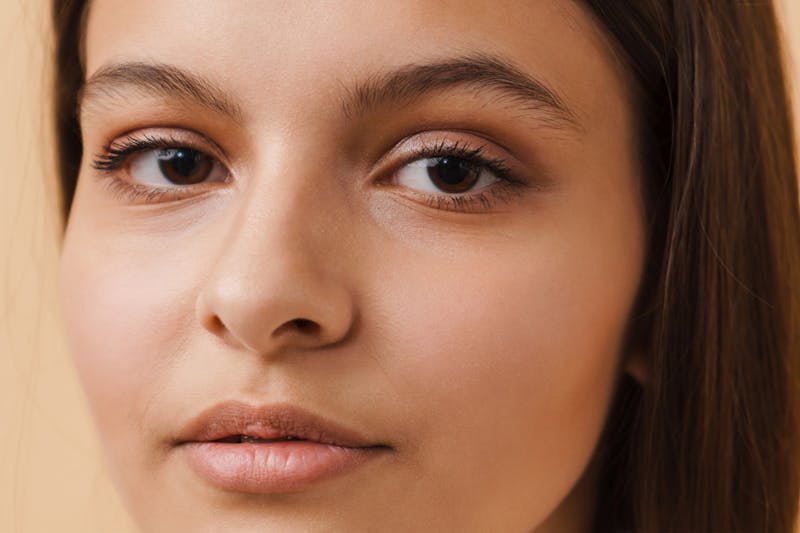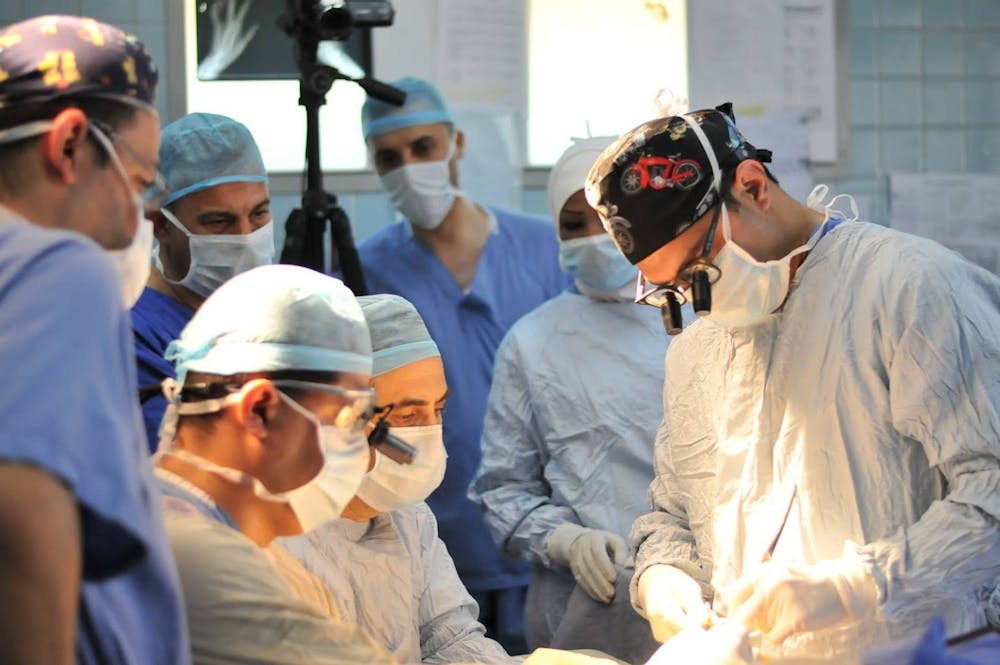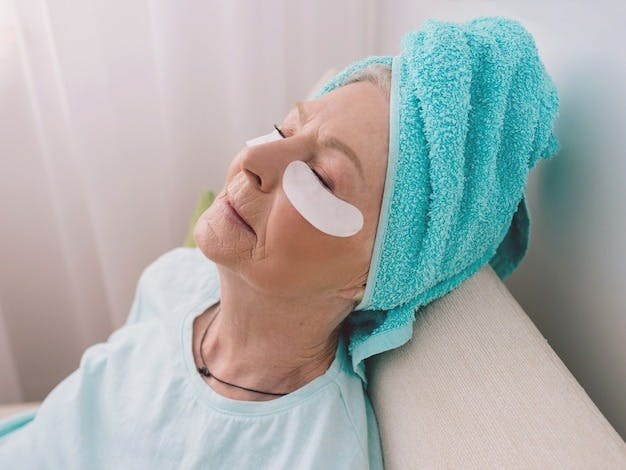
After you have eyelid surgery, it’s important to control the swelling to heal properly and feel more comfortable. This guide shares useful steps for handling swelling after your operation.
The suggestions here, based on Dr. Panossian‘s extensive knowledge and practical experience, cover everything from how to rest correctly to spot any issues that might need extra care. Following these post-operative instructions will help you heal well and get the results you’re looking for.
How to Reduce Swelling After Blepharoplasty
- Applying cold compresses to the eyes for the first few days after surgery helps minimize swelling.
- Keeping your head elevated, even while sleeping, can reduce swelling after eyelid surgery.
- Avoiding activities that strain your eyes, such as reading or using electronic devices, aids in faster recovery.
- Staying hydrated and consuming a low-salt diet helps reduce fluid retention, which can increase post-surgical swelling.
- Following your surgeon’s post-operative care instructions closely promotes quicker healing and less swelling.
Follow Your Surgeon’s Post-Op Instructions
After eyelid surgery, it’s important to manage swelling by following your surgeon’s advice on medications. Taking prescribed pain medications as instructed is crucial for reducing inflammation and pain. This approach helps ensure a smoother blepharoplasty recovery and assists in reducing swelling.
It is essential to discuss with your surgeon the use of any blood-thinning medications you might be taking, as these can increase the risk of potential complications such as bleeding and bruising. Your surgeon might recommend adjusting these medications before and after surgery to avoid any adverse effects. Ensuring clear communication about your medication regimen can significantly impact your recovery process and outcomes.
Importance of Attending Follow-up Appointments
In addition, attending all your follow-up appointments is crucial for good post-op care. During these visits, your surgeon checks on your wound healing and promptly addresses any issues. They also provide advice tailored to your situation to help lessen post-operative swelling and ensure your recovery is progressing well.
Apply Cold Compresses Regularly
In the first 48 hours after eye surgery, using cold compresses can help decrease swelling. Begin by wrapping ice packs in a soft cloth to avoid putting them directly on your skin, as this could lead to frostbite or irritation. Place them gently on the swollen areas around your eyes. Do this for about 10 minutes every hour for the best outcome.
Limitations and Precautions on Duration
While cold compresses are useful, it’s important to use them in moderation to avoid harming your skin. After the initial two days, use the compresses three or four times a day. If you start to feel discomfort or if you notice any signs of skin damage, stop using the compresses right away and talk to your surgeon. The goal is to reduce swelling safely after eyelid surgery.
Elevate Your Head
After eyelid surgery, it’s helpful to sleep with your head above heart level to lessen swelling. Lying on your back and using several pillows to prop up your head is the best way to achieve this. Try to avoid lying on your stomach or side, as it might lead to more swelling.
Tips for Comfortably Elevating Your Head
To ensure a comfortable night’s sleep with your head raised, consider using a wedge pillow or stacking extra pillows. Make sure your neck and head are supported well and without any discomfort.
Avoid Strenuous Activities
After a cosmetic surgery procedure, it’s essential to focus on a comfortable recovery process. Here’s how you can manage:
Activities to Avoid:
- Avoid heavy lifting, vigorous exercise, and anything that significantly increases your heart rate or blood pressure.
- These activities can exacerbate swelling and hinder eyelid surgery recovery.
Alternative Low-Impact Exercises
- Engage in gentle exercises like walking, gentle yoga, or stretching.
- Such activities promote blood flow and aid in the healing time without overstraining your body, helping to keep swelling in check.

Are You Ready For A Consultation?
If you are considering this procedure, booking a consultation with an experienced board-certified plastic surgeon like Dr. Panossian is a great way to learn about the procedure and determine if it’s right for you.
Stay Hydrated and Maintain a Healthy Diet
Eating a diet rich in certain foods and taking plenty of water is vital for healing after cosmetic plastic surgery. Here’s a simple guide to aid in proper healing:
Foods to Consume:
- Leafy greens, nuts, seeds, and lean meats
- Foods high in vitamin C and zinc for promoting healing
Foods to Avoid:
- Processed foods and sugary snacks
- Items high in sodium can cause inflammation and slow the recovery period
The Role of Water in Reducing Swelling
- Drinking water at least eight glasses a day is crucial.
- Being well-hydrated helps reduce swelling, flush out toxins, and ensure your body functions properly during the healing process.
Limit Salt Intake
- Eating too much salt can lead to more inflammation after surgery because it makes the body hold onto water.
- This extra water can delay healing.
- It’s important to watch how much salt you eat.
Recommended Daily Salt Intake for Recovery
- It’s often advised to keep sodium below 2,300 milligrams daily to control inflammation better.
- Lowering salt intake after plastic surgery can help the body heal faster by reducing swelling and discomfort.
Use Prescribed Eye Ointments or Drops
Proper Application Techniques
Using prescribed eye drops or ointments is key for healing after a surgical procedure. Follow these steps to apply safely:
- Wash Hands: Start by washing your hands thoroughly to reduce the risk of infection.
- Prepare for Application: Tilt your head back and gently pull down the lower eyelid to create a small pocket.
- Apply Medication: Carefully apply the medication into the pocket without letting the tip touch your eye or skin.
- Allow Absorption: Close your eyes for a few minutes post-application, giving the medication time to be absorbed.

Signs of Allergic Reactions or Side Effects
Be vigilant for any signs of allergic reactions or adverse effects:
- Mild Reactions: Look out for signs like redness, swelling, itching, or a rash.
- Severe Reactions: More serious symptoms can include changes in vision or pain.
Contact your doctor immediately upon noticing any concerning symptoms to adjust your treatment plan accordingly.
Protect Your Eyes
- Sunglasses: Choose dark sunglasses that block 100% of UV rays to protect the sensitive area around your eyes after eyelid surgery. This helps to reduce swelling and protects the healing eyelid skin.
- Hats: Pairing your sunglasses with a wide-brimmed hat offers the best protection by providing additional shade for your eyes and face.
- Contact lenses: Patients who wear contact lenses need to consult their surgeon about when they can resume using them post-surgery. Wearing contact lenses too soon after blepharoplasty can irritate the healing tissues and complicate recovery.
Understanding SPF for the Periocular Region
It’s important to apply sunscreen with a high SPF near your eyes to avoid sunburn and reduce the risk of skin color changes post-surgery. Opt for sunscreen products specifically designed for the face to prevent irritation.
Quit Smoking and Limit Alcohol Consumption
Quitting smoking and limiting alcohol consumption are important after a cosmetic procedure. Tobacco can make blood vessels smaller, which slows down healing. Alcohol can lead to more swelling and longer recovery times.
There are many resources to help people stop smoking and drink less alcohol. These include support groups, counseling services, and medical programs designed to improve health and aid recovery after a cosmetic procedure.
Recognize Signs of Infection or Complications
- Normal swelling: Gradually improves over days, usually even, and doesn’t majorly affect vision.
- Abnormal swelling: Gets worse over time, becomes uneven, or is accompanied by severe pain or discharge. These symptoms suggest a possible infection or complication.
When to Contact Your Surgeon
- Key signs: Excessive swelling, redness, discharge, fever or excessive bleeding
- Action: Contact your surgeon immediately. Cosmetic surgeons emphasize the importance of early intervention to manage issues effectively and prevent further problems.
Consult with an Experienced Plastic Surgeon
For advice on handling swelling after eyelid surgery, consider making an appointment with Dr. Andre Panossian in Pasadena, CA. He’s known worldwide for his skill in facial plastic surgery and offers extensive knowledge and experience to help with your care.
You can count on getting excellent results and care that’s made just for you. Trust Dr. Panossian to help you through your recovery. Schedule a consultation with him.


